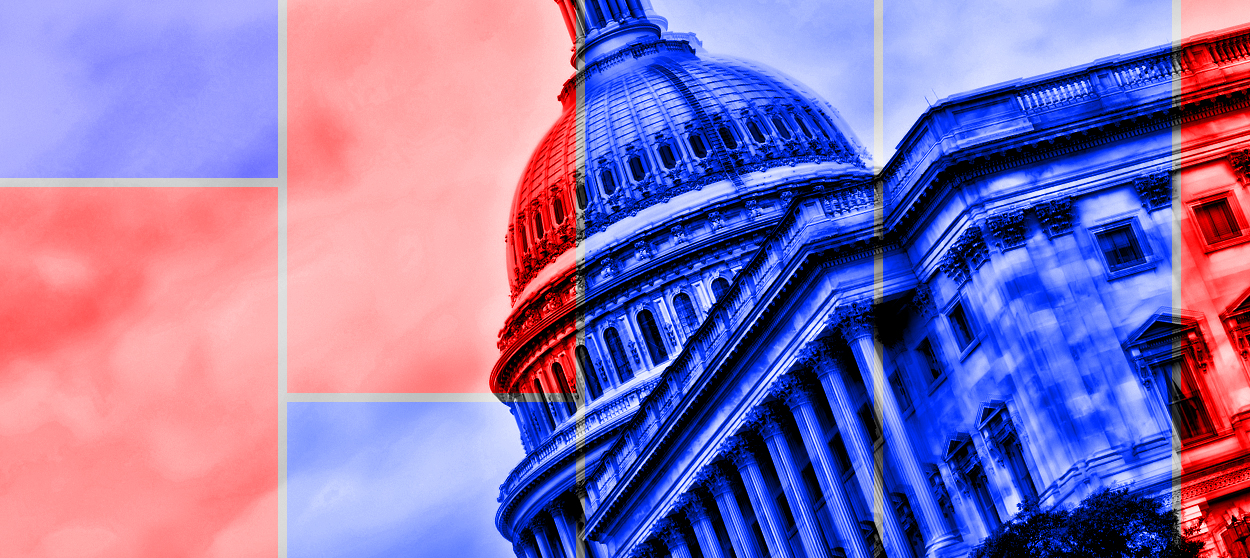What happened to the Democrats' blue wave?
Look beyond a few dozen House races, and it's clear there is no blue wave sweeping across the country, toppling Republican power from coast to coast with a historic surge of opposition to the president's party


Blue wave? What blue wave?
Yes, the Democrats seized control of the House of Representatives in Tuesday's midterm elections. That's a victory. Especially when it comes to Democratic oversight of the executive branch and the White House — including, most troublingly for the president, subpoena power.
This is big. It's important.
The Week
Escape your echo chamber. Get the facts behind the news, plus analysis from multiple perspectives.

Sign up for The Week's Free Newsletters
From our morning news briefing to a weekly Good News Newsletter, get the best of The Week delivered directly to your inbox.
From our morning news briefing to a weekly Good News Newsletter, get the best of The Week delivered directly to your inbox.
But look beyond a few dozen House races, and it's clear there is no blue wave sweeping across the country, toppling Republican power from coast to coast with a historic surge of opposition to the president's party.
Or rather, even if there was such a surge, it was matched by a counter-surge from the right that was strong enough to blunt it. Put somewhat differently: Turnout was enormous for a midterm election, but it was huge on both sides. The blue wave was met by a somewhat smaller but still sizeable and potent red wave. The Democrats ended up with a real and significant net gain in the House. But they lost several seats in the Senate — not to mention some painful gubernatorial losses in critical swing states like Ohio and Florida.
Democrats look likely to end up with around 230 seats in the House. That would be a pickup of 36. That's big. But it's not historic. It's more than Democrats picked up with Republicans in the White House in 1982 (26 seats) and 2006 (30 seats), but far less than Republicans won while Democrats held the presidency in 1994 (54 seats) or 2010 (63 seats). This would be true even if, when all the votes are counted in California, Democrats end up with something in the range of 238 seats (a pickup of 44).
And then there were the statewide races, where the supposed blue wave crashed against the walls of a Republican fortress and didn't leave a mark. The GOP is going to expand on its majority in the Senate, with Ted Cruz defeating Beto O'Rourke in Texas, Mike Braun prevailing over Joe Donnelly in Indiana, Marsha Blackburn taking down Phil Bredesen in Tennessee, and Josh Hawley trouncing Claire McCaskill in Missouri.
A free daily email with the biggest news stories of the day – and the best features from TheWeek.com
A similar story can be told in gubernatorial races. In Florida, Republican Ron DeSantis prevailed over liberal Democrat Andrew Gillum. In Ohio, Republican Mike DeWine won his contest with Democrat Richard Cordray.
Now, there were definitely some bright spots for Democrats in statewide contests. Kris Kobach came up short in his race for Kansas governor, for example. But the story of the night was not at all that of a dam breaking open, unleashing a flood of support for the Democrats. On the contrary, the story was the same one Americans have been confronting since the knife's edge dispute surrounding the 2000 presidential contest, and with far greater intensity since President Trump's victory two years ago: The United States is a nation sharply divided.
The precise contours of the division were clarified on Tuesday. Democrats won by huge margins in almost every city, and they made inroads in plenty of suburbs. But rural areas are now close to uniformly Republican. This is true just about everywhere — north, south, east, and west. That translated, with Trump in the White House acting as a constant provocation, into enough House districts to give the Democrats a slim but solid majority. But it also places a lot of relative low-population-density states firmly in the Republican column.
The battle between these architectonic urban-rural factions has shaped our politics for the better part of two decades now, and it's only going to continue and intensify. The House will go after the president, driven on by the outrage of Democratic voters who detest him. But Trump will train his rage on the House, keeping the Republican base in a state of constant hyper-partisan agitation as the country begins to gear up for the 2020 presidential race. And all the while the White House and the Senate will keep appointing conservative judges to the federal courts, ensuring further loyalty of Republican voters.
There is no exit in sight from the rancor and divisiveness of the past two years. No tranquility to follow the clamorous cacophony. No break in the logjam between the left and right. No decisive resolution of the clashes that define our public life. No sign that a firm, solid, decisive majority has repudiated President Trump and the poisonous politics he practices and encourages. We are stuck.
The Democrats did decently on Tuesday. But the trench warfare will continue. The political battles will grind on. The president will keep appealing to the worst in our country's past and present — because it works, or at least works well enough to keep him and his party in power across wide swaths of the country. And that is what matters to them.
The lesson of the 2018 midterm election is that this is our unsurpassable political reality. Democrats can win some battles, but they have not won the war. And there's no certainty that they ever will.
Damon Linker is a senior correspondent at TheWeek.com. He is also a former contributing editor at The New Republic and the author of The Theocons and The Religious Test.
-
 Bari Weiss’ ‘60 Minutes’ scandal is about more than one report
Bari Weiss’ ‘60 Minutes’ scandal is about more than one reportIN THE SPOTLIGHT By blocking an approved segment on a controversial prison holding US deportees in El Salvador, the editor-in-chief of CBS News has become the main story
-
 Has Zohran Mamdani shown the Democrats how to win again?
Has Zohran Mamdani shown the Democrats how to win again?Today’s Big Question New York City mayoral election touted as victory for left-wing populists but moderate centrist wins elsewhere present more complex path for Democratic Party
-
 Millions turn out for anti-Trump ‘No Kings’ rallies
Millions turn out for anti-Trump ‘No Kings’ ralliesSpeed Read An estimated 7 million people participated, 2 million more than at the first ‘No Kings’ protest in June
-
 Ghislaine Maxwell: angling for a Trump pardon
Ghislaine Maxwell: angling for a Trump pardonTalking Point Convicted sex trafficker's testimony could shed new light on president's links to Jeffrey Epstein
-
 The last words and final moments of 40 presidents
The last words and final moments of 40 presidentsThe Explainer Some are eloquent quotes worthy of the holders of the highest office in the nation, and others... aren't
-
 The JFK files: the truth at last?
The JFK files: the truth at last?In The Spotlight More than 64,000 previously classified documents relating the 1963 assassination of John F. Kennedy have been released by the Trump administration
-
 'Seriously, not literally': how should the world take Donald Trump?
'Seriously, not literally': how should the world take Donald Trump?Today's big question White House rhetoric and reality look likely to become increasingly blurred
-
 Will Trump's 'madman' strategy pay off?
Will Trump's 'madman' strategy pay off?Today's Big Question Incoming US president likes to seem unpredictable but, this time round, world leaders could be wise to his playbook



